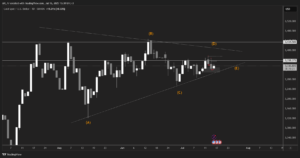Gold Reaches This Level Before the Release of Fed’s Preferred Inflation Data
Gold prices are set to incur a weekly loss, even as prices rise on Friday ahead of a key U.S. inflation reading that may provide more clues on when the Federal Reserve will cut interest rates. Last week, prices hit record highs amid bets on a U.S. rate cut in September. When prices rise sharply in a short period, a correction is often seen, but we remain optimistic about gold.
U.S. personal consumption expenditure (PCE) data for June—the Federal Reserve’s preferred inflation gauge—is scheduled for release at 12:30 GMT.
Data released on Thursday showed that the U.S. economy grew faster than expected in the second quarter, but inflationary pressures eased, leaving expectations for a September rate cut unchanged.
The appeal of non-yielding bullion tends to shine in a low-interest-rate environment.
With near-term support at $2,280, we still believe that gold could reach $2,680 by the end of the year. Additionally, U.S. elections and the surrounding political uncertainty, along with trade tensions between the U.S. and China, are other key factors that might lead to a significant rebound in prices.
Data showed that China’s net gold imports through Hong Kong fell by 18% in June compared to the previous month.
Gold and the Dollar Now
Spot gold rose by 0.3% to $2,370.62 per ounce but lost more than 1% over the week. U.S. gold futures increased by 0.8% to $2,371.30.
Other Metals
Spot silver fell by 0.7% to $27.77 per ounce, while platinum rose by 0.5% to $937.80. Both metals were on track for their third consecutive weekly decline. Palladium increased by 0.9% to $914.90.
Bets Increase on Larger-than-Expected First U.S. Rate Cut
Some investors are now betting that the Federal Reserve will cut interest rates more than expected. Fed funds futures markets on Thursday indicated a roughly 23% chance that the Fed will cut its key interest rate by at least 0.5 percentage points by September, according to CME Group data. This is up from 10% the previous day and 4.1% a week ago.
The Fed could achieve this either through two consecutive 0.25 percentage point cuts or a single large 0.5 percentage point cut. Part of the rise is attributed to increased bets on a distant rate cut, with a 0.25 percentage point reduction being priced in for next week’s meeting, rising to 11% from 6.2% the previous day, according to CME Group data.
These remain marginal bets. Most investors still believe the Fed will deliver its first rate cut of the cycle, a 0.25 percentage point cut, at its September meeting. The rise followed a stock market slump on Wednesday and weak U.S. manufacturing and housing data. Bets on a more aggressive Fed easing policy are also evident in the Treasury bond market, where short-term, policy-sensitive yields have fallen faster than those on longer-term debt.
GDP Data
On the other hand, the U.S. Commerce Department reported on Thursday that the U.S. economy grew much more than expected in the second quarter. The GDP, a broad measure of goods and services produced from April to June, increased at an annual rate of 2.8% in the preliminary reading, according to the department’s Bureau of Economic Analysis.
Economists had forecasted a 2% increase following a 1.4% rise in the first quarter of 2024. Consumer spending helped push the growth figure higher, with personal consumption expenditures rising 2.3% during the quarter, compared to a 1.5% increase in the first quarter. Spending on services and goods saw strong increases during this quarter.
There was some good news on the inflation front, as the Personal Consumption Expenditures Price Index, a key Fed measure, rose 2.6% during the quarter, down from 3.4% in the first quarter. Excluding food and energy, core PCE prices, which the Fed focuses on as a long-term inflation gauge, increased by 2.9%, down from 3.7% in the previous period.
Japanese Yen Delivers Impressive Weekly Performance Due to Unwinding of Carry Trades
The Japanese currency is trading near a two-and-a-half-month high.
• Rising inflationary pressures on the Bank of Japan ahead of next week’s meeting.
The Japanese yen rose in Asian market trading on Friday against a basket of global currencies, resuming its gains which had been momentarily halted against the U.S. dollar due to profit-taking and corrections, approaching again a two-and-a-half-month high with renewed open-buying activity.
The yen has delivered an impressive performance over the week, poised for its largest weekly gain since April, due to the accelerated unwinding of long-term carry trades ahead of the Bank of Japan’s meeting next week, and the full pricing of the possibility of a U.S. rate cut in September.
Official data showed that consumer prices in Tokyo rose in July, the latest inflation data from Japan indicating increasing inflationary pressures on the Bank of Japan’s policymakers.
Pricing Outlook
• Japanese yen exchange rate today: The dollar fell against the yen by 0.35% to 153.37¥, from an opening price of 153.91¥, and reached a high of 154.14¥.
• The yen lost less than 0.1% against the U.S. dollar on Thursday, marking its first loss in the last four days, due to corrections and profit-taking, after earlier reaching a two-and-a-half-month high of 151.94 yen per dollar.
Weekly Trading
Over this week, which officially ends with today’s price settlement, the yen is up more than 2.5% against the U.S. dollar, on track for its fourth consecutive weekly gain and its largest weekly gain since late April.
What is a Carry Trade?
A carry trade is one of the most important and widely used strategies by experts and traders in the trading world. It involves building long-term trading positions to benefit from interest rate differentials between currencies in the forex market.
Carry trades involve selling a low-yield currency and buying a high-yield currency, financing the trading position daily, weekly, or over any period chosen by the trader, allowing them to profit from the interest rate differential.
The low-yield currency is called the “funding currency,” and the high-yield currency is the “target currency.” In the USD/JPY pair, the target currency is the U.S. dollar, and the funding currency is the Japanese yen.
Traders borrow the low-yield yen via forward points daily or weekly or over another chosen period and lend the high-yield U.S. dollar via forward points.
If it is assumed that yields on the low-yield currency will continue to fall or that yields on the high-yield currency will continue to rise, daily financing of this trade is an easy way to achieve profits.
Unwinding of Carry Trade Positions
Currently, the unwinding of long-term carry trade positions in the Japanese yen is accelerating due to strong speculation surrounding the Bank of Japan’s upcoming monetary policy meeting.
Sources told Reuters that the Bank of Japan is likely to discuss whether to raise interest rates and unveil a plan to cut bond purchases by nearly half in the coming years, indicating its intention to steadily retreat from massive monetary stimulus.
Conversely, weak U.S. economic data have increased the likelihood of the Federal Reserve cutting U.S. interest rates by around 25 basis points in September from 94% to 100%, and in November from 98% to 100%.
Thus, the Bank of Japan is set to take new steps toward normalizing monetary policy for the world’s third-largest economy, while the Federal Reserve is nearing a policy easing and beginning a cycle of U.S. interest rate cuts.
Inflation in Tokyo
Data on Friday showed that core inflation in Tokyo rose by 2.2% annually in July, up from 2.1% in the previous month. Market expectations were for a 2.2% increase.
Prices in Japan are currently accelerating above the Bank of Japan’s 2.0% inflation target, which bolsters the likelihood of further increases in Japanese interest rates this year.
Disclaimer: This article is not investment advice or an investment recommendation and should not be considered as such. The information above is not an invitation to trade and it does not guarantee or predict future performance. The investor is solely responsible for the risk of their decisions. The analysis and commentary presented do not include any consideration of your personal investment objectives, financial circumstances, or needs.





